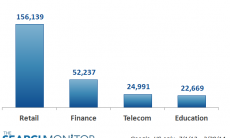 The state of the art in marketing and advertising and how they use big data, logic, and computing, is light years ahead of what most of us know. While many of us are just discovering the power of WordPress Plugins and freeish tools like MailChimp, the Fortune 500 have their entire companies wired for sound. They have their websites, eCommerce, mailing lists, social media, advertising, inboxes, CRMs, listening, and reporting all stitched into something that looks less and less like Frankenstein’s Monster, all patchwork and shoe horns, and more and more like one intuitive, integrated, holistic, and homogeneous system.
The state of the art in marketing and advertising and how they use big data, logic, and computing, is light years ahead of what most of us know. While many of us are just discovering the power of WordPress Plugins and freeish tools like MailChimp, the Fortune 500 have their entire companies wired for sound. They have their websites, eCommerce, mailing lists, social media, advertising, inboxes, CRMs, listening, and reporting all stitched into something that looks less and less like Frankenstein’s Monster, all patchwork and shoe horns, and more and more like one intuitive, integrated, holistic, and homogeneous system.
Now, they’re mostly semi-automatic, human-assisted, systems, but they’re quickly becoming not only fully automated, after a lot of front-end setup, but they’re verging on becoming automagical, possibly, one day, autonomous, problem-solving, creative, and adaptive. I wouldn’t be surprised if the first sentient, self-aware, software come in the form of a really sophisticated marketing automation system.
 I thought I knew the state of the art until I landed some work for SalesFusion and Pearson in 2015. For SalesFusion, I did deep research and reporting on the state of the marketing automation software (MAS) art. For Pearson, my job was to carefully read Outside-In Marketing: Using Big Data to Guide your Content Marketing, a book co-written by my friend and colleague Mike Moran and James Mathewson, and then contribute notes. So far, my career in marketing has been very much focused on the small and medium sized business (SMB), including non-profits, startups, tech companies, and even the social side of enterprises. As a consultant, however, my work has always been very hands-on, cobbling together tools I like and then using my big brain to analyze and synthesize.
I thought I knew the state of the art until I landed some work for SalesFusion and Pearson in 2015. For SalesFusion, I did deep research and reporting on the state of the marketing automation software (MAS) art. For Pearson, my job was to carefully read Outside-In Marketing: Using Big Data to Guide your Content Marketing, a book co-written by my friend and colleague Mike Moran and James Mathewson, and then contribute notes. So far, my career in marketing has been very much focused on the small and medium sized business (SMB), including non-profits, startups, tech companies, and even the social side of enterprises. As a consultant, however, my work has always been very hands-on, cobbling together tools I like and then using my big brain to analyze and synthesize.
In Mathewson’s and Moran’s upcoming book, Outside-In Marketing, a book on the future of content marketing as it benefits the sales cycle and search dominance of your business, the authors posit that form follows function and function follows the visitor and the visitor gets to define the evolution of your site, your content, and even your products and how they’re marketing.
 The biggest mistake, according to Mathewson and Moran, is that you don’t let the data define your choices. In the book, a multinational company was about to give their entire online brand an every three-year facelift to their websites and online properties. A CMO-type came in and shut it down, asking why: why do we need to do this aside from making the site look more modern and just because everyone else does? Are there any stats, data, or testing that you can show me right now that will prove to me that changing clothes, so to speak, would make a difference in our bottom line? Have you made any small tests in a portion of our massive online universe that can show a marked positive change in our visitors, our engagement, and our sales?
The biggest mistake, according to Mathewson and Moran, is that you don’t let the data define your choices. In the book, a multinational company was about to give their entire online brand an every three-year facelift to their websites and online properties. A CMO-type came in and shut it down, asking why: why do we need to do this aside from making the site look more modern and just because everyone else does? Are there any stats, data, or testing that you can show me right now that will prove to me that changing clothes, so to speak, would make a difference in our bottom line? Have you made any small tests in a portion of our massive online universe that can show a marked positive change in our visitors, our engagement, and our sales?
While I believe going mobile was not a choice over the last couple years — because of Google — it seems to me that the same sort of A/B testing and segmentation that people have been using for their email newsletters is now becoming affordable and accessible not only on the email list level but even at the website level.
 I remember, years ago, that Amazon was doing this. It was actively testing entire user interface (UI) changes on its website, real time. They would actively change fonts, emphasis, headlines, and even where content was, how big images were, and where to place the purchase button. To me, this was very cool but well out of range of everyone but an Amazon or an Ebay.
I remember, years ago, that Amazon was doing this. It was actively testing entire user interface (UI) changes on its website, real time. They would actively change fonts, emphasis, headlines, and even where content was, how big images were, and where to place the purchase button. To me, this was very cool but well out of range of everyone but an Amazon or an Ebay.
Another thing that Mathewson and Moran reminded me, and something that I started to think about when I was doing my reporting for SalesFusion, is that websites aren’t web pages and that pages are just convenient ways of referring to rendered data from one or more databases. As a result, it is possible for applications and services to get between your site’s database and the site rendering that your customers see. One example is CloudFlare, an awesome freeish CDN that I have easily and gladly integrated into my new personal blog, RNNR. It stands between what I render on my personal fitness blog and what everyone else sees.
While CloudFlare is “only” a caching platform tasked with staging exact copies of my blog around the globe, accessible to all, there are loads of other things that intermediary services can offer, marketing automation and sales funneling being only two of them.
 Over drinks a couple-few weeks ago at “our place,” Center Cafe, when he’s buzzing through Union Station, Mike told me that there are all sorts of cool intermediary tools that can actively, real-time, correct spelling, add text links, optimize for search in real time — especially useful for really old corporate sites that don’t have any concept of keyword- or content-optimization — and then, more relevantly, these intermediary tools, that are, at their heart, content delivery networks themselves, can really take your database, your historical content, and everything you are doing and have ever done and create structured data from your non-structured work, add taxonomy and classification, embed schema and localization data, and also customize the experience to each particular person who arrives, with more and more customization based on how much the software knows about the person, historically, or through API calls with other services. SoloSegment and Revealed Context being two of them Mike Moran recommends to his clients. What’s more, the sort of black magic and competitive advantage that only Amazon had in the past to do the sort of testing required to fully optimize the appeal of your website is finally becoming more accessible to mere mortals. For example, SalesFusion starts at $500/month and goes up from there. It may sound expensive but most have cost over $2,000/month until competition flooded in and CRMs and email marketing platforms have expanded into MAS as well.
Over drinks a couple-few weeks ago at “our place,” Center Cafe, when he’s buzzing through Union Station, Mike told me that there are all sorts of cool intermediary tools that can actively, real-time, correct spelling, add text links, optimize for search in real time — especially useful for really old corporate sites that don’t have any concept of keyword- or content-optimization — and then, more relevantly, these intermediary tools, that are, at their heart, content delivery networks themselves, can really take your database, your historical content, and everything you are doing and have ever done and create structured data from your non-structured work, add taxonomy and classification, embed schema and localization data, and also customize the experience to each particular person who arrives, with more and more customization based on how much the software knows about the person, historically, or through API calls with other services. SoloSegment and Revealed Context being two of them Mike Moran recommends to his clients. What’s more, the sort of black magic and competitive advantage that only Amazon had in the past to do the sort of testing required to fully optimize the appeal of your website is finally becoming more accessible to mere mortals. For example, SalesFusion starts at $500/month and goes up from there. It may sound expensive but most have cost over $2,000/month until competition flooded in and CRMs and email marketing platforms have expanded into MAS as well.
 And while $500/month might seem expensive, tools like SalesFusion and other marketing automation software (MAS) take over a multitude of services: visitor tracking, social publishing and sharing, social listening, AdWords integration and tracking, SEO analysis, email newsletter tools, mobile response themes, A/B testing and segmenting, lead capture, automated trigger campaigns, personalized content, lead managing and scoring, CRM integration, reporting, ROI analysis, web analytics, goal tracking, and I am now out of breath. There’s more but I don’t get some of it as I am not a sales maven. So, that $500/month could be considered rent, especially if you don’t support a brick and mortar business but are doing all your sales and marketing online. How many hours would an MAS save you? Then again, will that MAS be like your gym membership? Will you buy it and then not be willing to put the front-end time and resources in in order to make all the magic happen? It’s about priorities. Marketing Automation Software Platforms don’t work the magic by themselves, they require some planning and devotion to really get the most out of them. But, according to my girlfriend, who works for a Fortune 500 company and basically lives in her CRM and her MAS, she really couldn’t do any of it without them.
And while $500/month might seem expensive, tools like SalesFusion and other marketing automation software (MAS) take over a multitude of services: visitor tracking, social publishing and sharing, social listening, AdWords integration and tracking, SEO analysis, email newsletter tools, mobile response themes, A/B testing and segmenting, lead capture, automated trigger campaigns, personalized content, lead managing and scoring, CRM integration, reporting, ROI analysis, web analytics, goal tracking, and I am now out of breath. There’s more but I don’t get some of it as I am not a sales maven. So, that $500/month could be considered rent, especially if you don’t support a brick and mortar business but are doing all your sales and marketing online. How many hours would an MAS save you? Then again, will that MAS be like your gym membership? Will you buy it and then not be willing to put the front-end time and resources in in order to make all the magic happen? It’s about priorities. Marketing Automation Software Platforms don’t work the magic by themselves, they require some planning and devotion to really get the most out of them. But, according to my girlfriend, who works for a Fortune 500 company and basically lives in her CRM and her MAS, she really couldn’t do any of it without them.
 I don’t know if you guys have tried some of the cool plugins from Zemanta but they’ll give you a taste for how an intermediary service can really get between your site on the server, your database, and how it’s rendered to you in the browser. I use Editorial Assistant and Related Posts on my RNNR site. And I have gotten all the sites that I blog for to use Editorial Assistant as a way to speed up linking and creating meta tags. I love it. But, Zemanta isn’t really installed on my server, it lives in the cloud between my hosting company and both my browser and my visitors’ browsers.
I don’t know if you guys have tried some of the cool plugins from Zemanta but they’ll give you a taste for how an intermediary service can really get between your site on the server, your database, and how it’s rendered to you in the browser. I use Editorial Assistant and Related Posts on my RNNR site. And I have gotten all the sites that I blog for to use Editorial Assistant as a way to speed up linking and creating meta tags. I love it. But, Zemanta isn’t really installed on my server, it lives in the cloud between my hosting company and both my browser and my visitors’ browsers.
 At the end of the day, anyone who suggests that big data is the future and that every single kilobyte of your online data isn’t scrutinized and weaponized just wants to calm your paranoid brain. Now, it’s your turn to get in on this as a marketer. Until now, only the Amazons and Bloombergs of the world could afford the time, money, and resources required to buy into these very expensive and very powerful tools. Not anymore.
At the end of the day, anyone who suggests that big data is the future and that every single kilobyte of your online data isn’t scrutinized and weaponized just wants to calm your paranoid brain. Now, it’s your turn to get in on this as a marketer. Until now, only the Amazons and Bloombergs of the world could afford the time, money, and resources required to buy into these very expensive and very powerful tools. Not anymore.
While $500/month may well be a lot of money to spend on the unknown, think of it this way: $500 is nothing if it allows you access to all the advantages that the big boys have been using for years.
It might be time to take the leap of faith and turn your brochureware site into a literal cach register (I almost wrote cache register). I can’t wait until I reach the point in my company where this makes sense. But maybe you are. And maybe an MAS is the only way, in the super-competitive online world, to compete and it might be the competitive advantage you need to take you to the next step in the ladder in 2016.
Good luck and go git ’em tiger!





